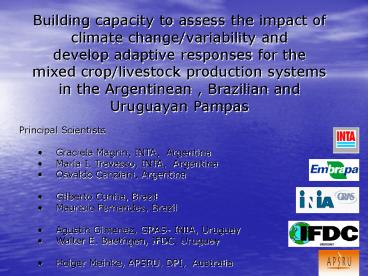Diapositiva 1 - PowerPoint PPT Presentation
1 / 39
Title:
Diapositiva 1
Description:
Uruguayan Pampas. Principal Scientists. Graciela ... Uruguayan Pampas Region ... Argentinean Pampas Region. Mean Values. Differences in three-monthly ... – PowerPoint PPT presentation
Number of Views:26
Avg rating:3.0/5.0
Title: Diapositiva 1
1
Building capacity to assess the impact of
climate change/variability and develop adaptive
responses for the mixed crop/livestock
production systems in the Argentinean ,
Brazilian and Uruguayan Pampas
- Principal Scientists
- Graciela Magrin, INTA, Argentina
- María I. Travasso, INTA, Argentina
- Osvaldo Canziani, Argentina
- Gilberto Cunha, Brazil
- Mauricio Fernandes, Brazil
- Agustin Gimenez, GRAS- INIA, Uruguay
- Walter E. Baethgen, IFDC, Uruguay
- Holger Meinke, APSRU, DPI, Australia
2
AIACC Projects
System Under Current Conditions
System Under Future Conditions
IMPACTS ADAPTATION
Future Conditions Include Climate Change
Scenarios Include Scenarios of Other Changes
3
Climate Scenarios
Great uncertainty of climate change at regional
or local scales
AIACC Globally Produce Scientific Results
(e.g., IPCCs FAR )
AIACC Regionally and Locally Introduce CC in
the Political Agenda. (Planning and Decision
Making)
Uncertainty must be managed to still be useful
4
Climate Scenarios
Due to uncertainty of climate change at regional
or local scales, we are considering a range of
possible climates for the assessment of impacts
of climate change on agricultural production
including
- GCM outputs (based on IPCC SRES)
- Sensitivity (ranges of Temp, Precip,
Variability) - Project changes in the future considering
changes in the last century - Generate daily data sets (for crop and pasture
simulation models) IMPACTS and ADAPTATION
5
Methods for Generating Climate Change
Scenarios Needed for the Simulation Models
(Crops, Pastures)
GCMs 1. Use Generated
Climate Change Scenarios (Direct Output from
GCM runs) (No) 2. Use RCM nested in GCM
(hopefully) 3. Use GCM to get atmospheric
variables and generate (e.g.) rainfall 4.
Use Projected GCM Anomalies (Projected GCM
Climatology GCM) and Modify Observed Climatic
Data
Evaluate GCMs Ability to Represent
Current Conditions (Start with Climatology)
6
(No Transcript)
7
(No Transcript)
8
(No Transcript)
9
Climate Scenarios
- 1. GCM outputs (based on IPCC SRES)
- 2. Sensitivity (ranges of Temp, Precip,
Variability) - SCENARIOS are a COMBINATION of
- 1, 2 . oC (different months)
- Tmax and Tmin
- /- 10, 20 . Rainfall
- (different months)
- Changes in Means, Variability and Extremes
10
Sensitivity (ranges of Temp, Precip,
Variability)
Pro Range will likely cover reality Con
Range might be too wide to be useful
11
Climate Scenarios
- 1. GCM outputs (based on IPCC SRES)
- Sensitivity (ranges of Temp, Precip,
Variability) - 3. Project changes in the future considering
changes in the last century
12
Changes in CLIMATE during the 20th century in
the Argentinean and Uruguayan Pampas
Region (will add South Brazil)
13
Differences in three-monthly Precipitation (mm)
between 1900-1930 and 1970-2000 in nine sites of
the Argentinean Pampas Region
Mean Values
14
Differences in three-monthly Precipitation (mm)
between 1930 and 2002 in eleven sites of the
Uruguayan Pampas Region
Mean Values
JAS OND JFM AMJ
JAS OND JFM AMJ
15
Differences in three-monthly Minimum Temperature
(ºC) between 1950-1970 and 1970-2000 in nine
sites of the Argentinean Pampas Region
Mean Values
16
Differences in three-monthly Minimum Temperature
(ºC) between 1915-1950 and 1950-2000 in one site
of the Uruguayan Pampas Region
JAS OND JFM
AMJ
17
Differences in three-monthly Maximum Temperature
(ºC) between 1950-1970 and 1970-2000 in nine
sites of the Argentinean Pampas Region
Mean Values
18
Differences in three-monthly Maximum Temperature
(ºC) between 1915-1950 and 1950-2000 in one site
of the Uruguayan Pampas Region
JAS OND JFM
AMJ
19
Differences in Number of Storms between
1911-1970 and 1980-2000 in eigth sites of the
Argentinean Pampas Region
gt60mm
gt80mm
gt100mm
gt240
gt350
gt530
20
Changes in FROST Frequency and Intensity in
eigth sites of the Argentinean Pampas Region
21
ARGENTINA SUMMARY OF CHANGES
22
URUGUAY SUMMARY OF CHANGES (1915-1970 vs
1980-2002)
23
Changes in Crop yields During the 20th century
Yield increases () between 1950-70 and 1970-00
24
Characterize Climate Changes In the last
Century to Generate Synthetic
Weather Scenarios Projecting Observed Climate
Changes
25
Changes in median values between 1930-1960 and
1970-2000
26
LARS-WG
A Stochastic Wheather Generator for use in
Climate Impact Studies
M.A. Semenov
27
Scenarios Comparison Precipitation
1- Last 30 years 2- Synthetic serie 3- Future
scenario (quarter)
28
October Rainfall in SW Uruguay 1915 - 2002
29
October Rainfall in SW Uruguay 1915 - 2002
Linear regression and Binomial smoothing
30
October Rainfall in SW Uruguay 1915 - 2002
y 0.74 x - 1359 R2 0.49 (7.4 mm cada 10 años)
Linear regression and Binomial smoothing
31
Method 2 Characterize Changes in Statistical
Parameters During the last Century Use TRENDS
for Generating Future Climate Scenarios
SERIES WET and DRY WET and DRY series mean
and sd DISTRIBUTIONS OF RAIN RAIN MONTHLY
max, min, N, mean and sd MAX MONTHLY max, min,
N, mean and sd MAX DAILY max, min, N, mean and
sd MIN MONTHLY max, min, N, mean and sd MIN
DAILY max, min, N, mean and sd SPELLS of FROST
and HOT TEMPERATURE WET MIN WET MAX DRY
MIN DRY MAX
32
(No Transcript)
33
(No Transcript)
34
(No Transcript)
35
(No Transcript)
36
1. Characterize changes in statistical
parameters 2. Project the trend for the next 30
years
37
Climate Scenarios
- GCM outputs (based on IPCC SRES)
- Sensitivity (ranges of Temp, Precip,
Variability) - Project changes in the future considering
changes in the last century
38
(daily data) Crop/Pasture Models
39
(No Transcript)

